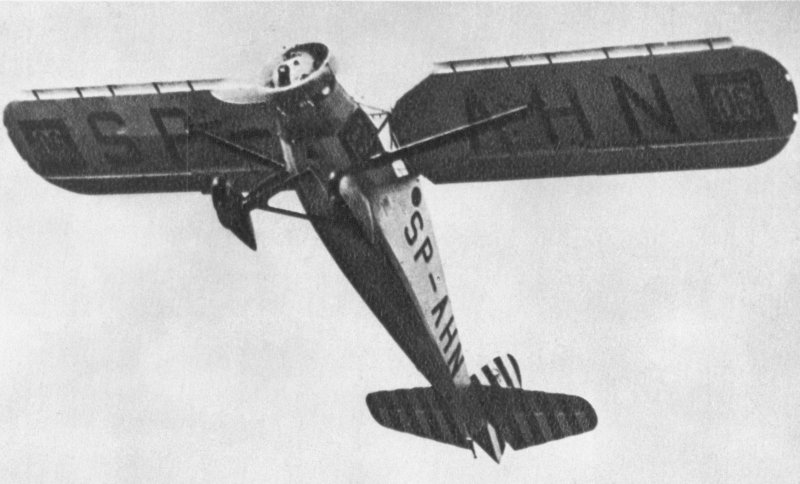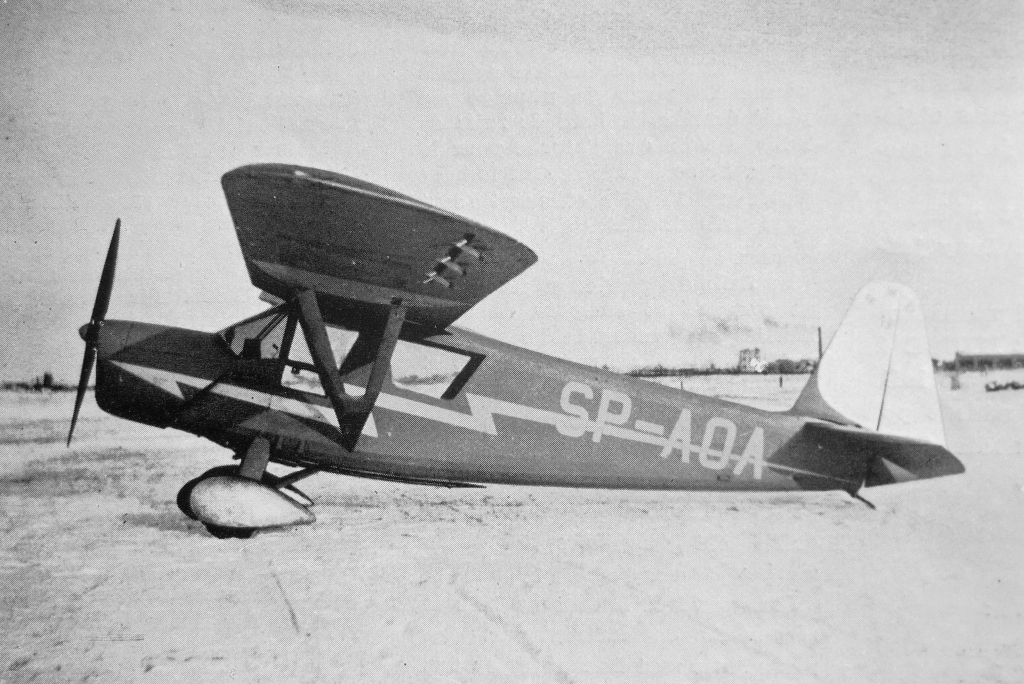RWD (aircraft Manufacturer) on:
[Wikipedia]
[Google]
[Amazon]
RWD was a Polish
 They started work while studying at
They started work while studying at  At first, the RWD team designed and built light sport planes. Early designs RWD-2 and
At first, the RWD team designed and built light sport planes. Early designs RWD-2 and



RWD aeroplanes
History of RWD and DWL works
(Polish and French)
RWD-6 Replica Project
{{DEFAULTSORT:Rwd (Aircraft Manufacturer) Aircraft manufacturers of Poland Science and technology in Poland Polish brands
aircraft
An aircraft is a vehicle that is able to fly by gaining support from the air. It counters the force of gravity by using either static lift or by using the dynamic lift of an airfoil, or in a few cases the downward thrust from jet engine ...
construction bureau active between 1928
Events January
* January – British bacteriologist Frederick Griffith reports the results of Griffith's experiment, indirectly proving the existence of DNA.
* January 1 – Eastern Bloc emigration and defection: Boris Bazhan ...
and 1939. It started as a team of three young designers, Stanisław Rogalski
Stanisław Rogalski (25 May 1904 – 6 February 1976) was a Polish aircraft designer, born in Olomouc, best known as one of the founding trio of the inter-war period RWD airplane factory in Warsaw. He obtained his degree at Warsaw University of ...
, Stanisław Wigura
Stanisław Wigura (9 April 1901 – 11 September 1932) was a Polish aircraft designer and aviator, co-founder of the RWD aircraft construction team and lecturer at the Warsaw University of Technology. Along with Franciszek Żwirko, he won the in ...
and Jerzy Drzewiecki
Jerzy Drzewiecki (7 August 1902 – 15 May 1990) was a Polish aeroplane constructor, an engineer and one of the founders of the RWD construction bureau, along with Rogalski and Wigura. He was born in Warsaw
Warsaw ( pl, Warszawa, ), of ...
, whose names formed the RWD acronym.
History
 They started work while studying at
They started work while studying at Warsaw University of Technology
The Warsaw University of Technology ( pl, Politechnika Warszawska, lit=Varsovian Polytechnic) is one of the leading institutes of technology in Poland and one of the largest in Central Europe. It employs 2,453 teaching faculty, with 357 professor ...
. In December 1925, with some other student constructors, they set up workshops at the Aviation Section of Mechanics Students' Club (''Sekcja Lotnicza Koła Mechaników Studentów''), where they manufactured their first designs. From 1926 they designed several aircraft alone ( Drzewiecki JD-2 and WR-1), in 1928
Events January
* January – British bacteriologist Frederick Griffith reports the results of Griffith's experiment, indirectly proving the existence of DNA.
* January 1 – Eastern Bloc emigration and defection: Boris Bazhan ...
they joined forces as one team, starting with RWD-1
The RWD 1 was a Polish sports plane of 1928 in aviation, 1928, a single-engine high-wing monoplane constructed by the RWD (aircraft manufacturer), RWD design team.
Development
The RWD 1 was the first aircraft constructed by the RWD (aircraft manu ...
sportsplane. Apart from building planes, J. Drzewiecki was a test pilot of their designs, while S. Wigura flew as a mechanic in competitions. In 1930 the team was moved to new workshops at Okęcie
Okęcie () is the largest neighbourhood of the Włochy district of Warsaw, Poland.
It is the location of Warsaw Chopin Airport and the PZL Warszawa-Okęcie aircraft works, and home to the Okęcie Warszawa professional association football clu ...
district in Warsaw, near the Okęcie aerodrome, today's Warsaw International Airport, founded by the LOPP
Air and Chemical Defense League (Polish: ''Liga Obrony Powietrznej i Przeciwgazowej'', ''L.O.P.P.'') was a mass Polish paramilitary organization, founded in 1928 as a result of the merger of the ''State Air Defense League'' (Polish: ''Liga Obron ...
paramilitary organization. On 11 September 1932, Stanisław Wigura
Stanisław Wigura (9 April 1901 – 11 September 1932) was a Polish aircraft designer and aviator, co-founder of the RWD aircraft construction team and lecturer at the Warsaw University of Technology. Along with Franciszek Żwirko, he won the in ...
died in an air crash in the RWD-6
The RWD 6 was a Polish sports plane of 1932, constructed by the RWD team. It was a winner of the Challenge 1932 international tourist aircraft contest.
Development
The aircraft was designed specially for the purpose of competing in the internati ...
during a storm, but the RWD name continued to be used for new designs (according to a popular story, the letter W now ''de facto'' stood for engineer Jerzy Wędrychowski, but he was not a designer). In 1933, Rogalski, Drzewiecki and Wędrychowski founded the company ''Doświadczalne Warsztaty Lotnicze
Doświadczalne Warsztaty Lotnicze (DWL) (''Experimental Aeronautical Workshops'') was the Polish aircraft manufacturer, active in 1933-1939. It was a home of the RWD construction team and manufactured aircraft under a brand RWD.
History
The ...
'' (DWL, Experimental Aeronautical Works) in Warsaw, which became a manufacturer of further RWD aircraft. Apart from Rogalski and Drzewiecki,the construction bureau employed designers Tadeusz Chyliński,Andrzej Glass (2003). ''Słownik biograficzny techników polskich'', SBTP: Warsaw, p. 24: fragment of its entry about Tadeusz Chyliński: ( pl, W 1937 r. podjął prace w Doświadczalnych Warsztatach Lotniczych (RWD) jako konstr., jednocześnie kontynuowal studia. Pracował przy dok. seryjnej samolotu obserwacyjnego RWD-14 Czapla
The RWD-14 Czapla (LWS Czapla) was a Polish army cooperation aircraft (observation, close reconnaissance and liaison aircraft), designed in the mid-1930s by the RWD team, and produced in the LWS factory from 1938. A series of 65 aircraft were b ...
, następnie zaprojektował plat samolotu zawodniczego RWD-19
The RWD-19 was a Polish two-seat low-wing sports aircraft of 1938, constructed by the RWD bureau.
Development
The RWD-19 was designed in 1937-1938 in the RWD bureau. The chief designer was Jerzy Drzewiecki. Designer Tadeusz Chyliński designed ...
, kadlub samolotu dyspozycyjnego RWD-18
The RWD 18 was a four/five seat STOL (Short Take-Off and Landing) utility aircraft designed and built in Poland from 1936.
Development
DWL studied a small twin-engined STOL utility aircraft as a private venture due to the lack of official suppo ...
, łoże silnika do samolotu szk. RWD-23 i dźwigar płata samolotu myśliwskiego RWD-25 __NOTOC__
The RWD-25 was a proposed Polish low-wing light fighter aircraft of 1939 designed by RWD. The project was abandoned when Poland was invaded.
Design and development
In late 1930s the Polish Army sought several replacements for the ra ...
. W l. 1933–38 byl czl. Sekcji Lotniczej Kola Mechaników Stud. PW.) Bronisław Żurakowski, Leszek Dulęba
Leszek () is a Slavic Polish male given name, originally ''Lestko'', ''Leszko'' or ''Lestek'', related to ''Lech'', ''Lechosław'' and Czech ''Lstimir''.
Individuals named Leszek celebrate their name day on June 3.
Notable people
* Lestko
* L ...
and Andrzej Anczutin
Andrzej is the Polish form of the given name Andrew.
Notable individuals with the given name Andrzej
* Andrzej Bartkowiak (born 1950), Polish film director and cinematographer
* Andrzej Bobola, S.J. (1591–1657), Polish saint, missionary and ...
and several engineers, including Henryk Millicer.
 At first, the RWD team designed and built light sport planes. Early designs RWD-2 and
At first, the RWD team designed and built light sport planes. Early designs RWD-2 and RWD-4
The RWD 4 was a Polish sports plane of 1930, constructed by the RWD team.
Development
The RWD 4 was constructed by the RWD team of Stanisław Rogalski, Stanisław Wigura and Jerzy Drzewiecki in Warsaw. It was based upon their earlier RWD 2 de ...
were built in small series and used in Polish sports aviation, including their debut at the Challenge 1930 The International Touring Competition in 1930 (french: Challenge International de Tourisme) was the second Fédération Aéronautique Internationale, FAI international touring aircraft contest, that took place between July 18 and August 8, 1930 in B ...
international contest. Their next designs performed particularly well in competitions - the RWD-6
The RWD 6 was a Polish sports plane of 1932, constructed by the RWD team. It was a winner of the Challenge 1932 international tourist aircraft contest.
Development
The aircraft was designed specially for the purpose of competing in the internati ...
won the Challenge 1932 The Challenge 1932 was the third FAI International Tourist Plane Competition (french: Challenge International de Tourisme), that took place between 12 and August 28, 1932 in Berlin, Germany. The four Challenges, from 1929 to 1934, were major aviat ...
and RWD-9
The RWD 9 was a Polish sports plane of 1934, constructed by the RWD team.
Development
The aircraft was a further development of the RWD 6 - the winner of the ''IIIrd Challenge de Tourisme International'' Challenge 1932 international tourist airc ...
s won the Challenge 1934 international contest. The RWD-5 sport plane was the lightest plane to fly across the Atlantic
The Atlantic Ocean is the second-largest of the world's five oceans, with an area of about . It covers approximately 20% of Earth's surface and about 29% of its water surface area. It is known to separate the " Old World" of Africa, Europe an ...
in 1933. Three types saw mass production: the RWD-8
The RWD 8 was a Polish parasol wing monoplane trainer aircraft produced by RWD. It was used from 1934 to 1939 by the Polish Air Force and civilian aviation.
Development
The RWD 8 was designed in response to a Polish Air Force requirement in 19 ...
, which became the Polish Air Force's basic trainer, the RWD-13
The RWD 13 was a Polish touring plane of 1935, three-seater high-wing monoplane, designed by the RWD team. It was the biggest commercial success of the RWD.
Development
The RWD 13 was a touring plane, developed from a line of sports planes RWD ...
touring plane and the RWD-14 Czapla
The RWD-14 Czapla (LWS Czapla) was a Polish army cooperation aircraft (observation, close reconnaissance and liaison aircraft), designed in the mid-1930s by the RWD team, and produced in the LWS factory from 1938. A series of 65 aircraft were b ...
reconnaissance plane (1938).
Other important designs were the RWD-10
The RWD-10 was a Polish aerobatics sports plane, single-seat parasol wing monoplane, used from 1933 to 1939 and constructed by the RWD team.
Development
The aircraft was designed as a single-seater aerobatic sports plane that could also be used ...
aerobatic plane (1933), RWD-17
The RWD 17 was a Polish aerobatics-trainer aircraft of 1937, parasol wing monoplane, constructed by the RWD team.
Development
The aircraft was designed for an order of the LOPP paramilitary organization, as an interim trainer aircraft between ...
aerobatic-trainer plane (1937) and RWD-21 light sport plane (1939). World War II
World War II or the Second World War, often abbreviated as WWII or WW2, was a world war that lasted from 1939 to 1945. It involved the vast majority of the world's countries—including all of the great powers—forming two opposing ...
prevented further development and serial production of later RWD designs, and put an end to the RWD construction bureau and the DWL production plant.
Aircraft



References
Footnotes
Notes
Bibliography
* Glass, Andrzej: "Polskie konstrukcje lotnicze 1893-1939" (''Polish Aviation Designs 1893-1939''), WKiŁ, Warsaw 1977 * Glass, Andrzej: "Slownik biograficzny technikow polskich" (''The Biographical Dictionary of Polish Engineers''), SBTP, Warsaw 2003External links
RWD aeroplanes
History of RWD and DWL works
(Polish and French)
RWD-6 Replica Project
{{DEFAULTSORT:Rwd (Aircraft Manufacturer) Aircraft manufacturers of Poland Science and technology in Poland Polish brands